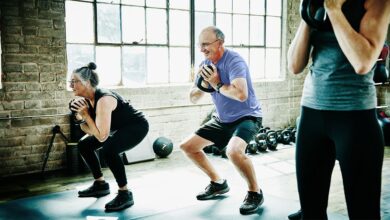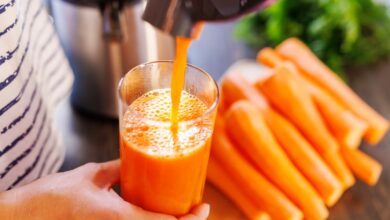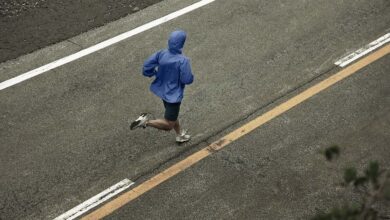1-minute bursts of physical activity during daily tasks could help you live longer

- A new study offers an alternative for older adults who are unable to commit to a regular exercise regimen.
- According to the international research team, a few minutes of energetic everyday movements may reduce the risk of early death.
- The research, which uses wearable technology, is the first of its kind to assess the health benefits of “vigorous intermittent lifestyle physical activity” (VILPA).
- The researchers hope that global physical activity guidelines could become updated to promote VILPA.
The World Health Organization (WHO) states that at least
But new research from an international team at the University of Sydney in Australia suggests that simply turning up the effort in daily activities can help mitigate that risk significantly and prolong life.
Emmanuel Stamatakis, Ph.D., professor of physical activity, lifestyle, and population health at the University of Sydney’s Charles Perkins Centre, led a study showing that three to four 1-minute episodes of robust motion can lower all-cause and cancer-related death risks by up to 40%.
The analysis also suggests that short periods of brisk moves like power walking can reduce cardiovascular disease-related mortality by up to 49%.
The study is the first to capture movement patterns and measure the health benefits of what the researchers call “vigorous intermittent lifestyle physical activity” or VILPA.
“Our study shows similar benefits to can be achieved through increasing the intensity of incidental activities done as part of daily living — and the more the better,” Dr. Stamatakis told Medical News Today.
The findings were recently published in
The University of Sydney team and other research institutions emphasize that “all activity counts,” regardless of location and length.
Vigorous intermittent lifestyle physical activity (VILPA) refers to 1- to 2-minute periods of vigorous physical activity performed within everyday tasks, such as walking with shopping bags or climbing a flight of stairs.
VILPA activities can also help to get your heart rate up.
“VILPA is mostly relevant to adults, in particular middle-aged people and over who are at imminent risk of developing chronic disease and die prematurely, partly as the result of physical inactivity and other lifestyle risk factors.”
– Emmanuel Stamatakis, Ph.D., lead study author
According to Dr. Stamatakis, VILPA might be more feasible than regular exercise for adults who are not fit or active “because it requires minimal time commitment and involves no specific preparation, equipment or access to facilities,” he said.
Current health guidelines are largely based on evidence from questionnaires that have only considered the health value of 10 or more minutes of gym-based physical activity.
Wearable technology enabled the researchers to track smaller segments of time and movement intensity with incredible precision.
Unlike questionnaires, wrist or thigh accelerometers can continuously record “micro-patterns” of VILPA activity, movements previously difficult or impossible to track.
The devices also allowed researchers to understand the health effects of these movements.
The Charles Perkins Centre team gathered data from a sample of 14,178 self-identified women and 11,063 self-identified men in the UK Biobank, a biomedical database. The participants’ mean age was about 62 years old.
The subjects reported no exercise or sports participation at the baseline and a reexamination 7 years later.
Accelerometers recorded VILPA bouts in 10-second increments. About 92% of VILPA bouts lasted up to 1 minute and 98% lasted up to 2 minutes.
The researchers found that three 1-minute VILPA episodes per day were associated with nearly a 50% reduction in cardiovascular mortality risk compared to no VILPA. These would add up to under 30 minutes a week.
More VILPA bouts also correlated with lower early death risks compared to no VILPA. The maximum 11 bouts per day were associated with 49% lower cancer-related deaths and 65% lower cardiovascular disease-related deaths.
A comparative analysis of 62,344 exercisers gathered similar data, suggesting that VILPA is as effective as vigorous, intentional activity.
In a March 2020 podcast, David Brown, a senior behavioral scientist with the
“Physical activity can help us feel better, age better, and improve our quality of life so we can keep doing the things we enjoy. Benefits include improved muscle strength, bone health, and physical function which are especially important for helping older adults prevent falls and maintain independence for as long as possible.”
– David Brown, behavioral scientist
Brown also mentioned in the podcast that people aged 65 and older should maintain a regimen of aerobic, balance, and muscle-strengthening exercises.
The CDC recommends exercises that involve multiple components to help improve physical function. Many moves are already a part of everyday tasks, chores, and recreational activities.
Here are a few tips to incorporate more VILPA into your everyday:
- Stretching: Stretch a target area such as the neck, hips, hamstrings, or ankles for up to 30 seconds. This helps loosen muscles and reduce the risk of injury.
- One-leg balance: Standing close to a chair or wall, stand on one leg for a few seconds. Switch to the other leg. This move can help enhance mobility, joint stability, bone strength, and muscle tone.
- Heel raises: Sit up tall in a chair with feet flat on the floor. Lift heels to rise on the balls of the feet, then lower to the starting position. This exercise can help improve balance and lower the risk of foot, ankle, or back pain.
- Chair-based exercises such as neck stretches, side bends, and thigh squeezes take less than a minute as well.
As impressive as VILPA appears in his study, Dr. Stamatakis encourages intentional exercise for middle- and older age adults.
“Leisure time exercise is still a fantastic option as it is the kind of movement that has been specifically designed for health, fitness, and recreation,” Dr. Stamatakis said.
“People who already have an established and regular routine of leisure-time exercise should stick to it, and treat VILPA as complementary to their regular routine, not as a replacement of exercise.”
Dr. Stamatakis maintains that his findings are relevant to most middle-aged adults — over 80% — who do not exercise regularly.
If you’re interested in adding more VILPA to your everyday routine or ramping up your exercise regimen, you may wish to ask your healthcare professional for more guidance, especially if you have an underlying health condition.
Get Best News and Web Services here







